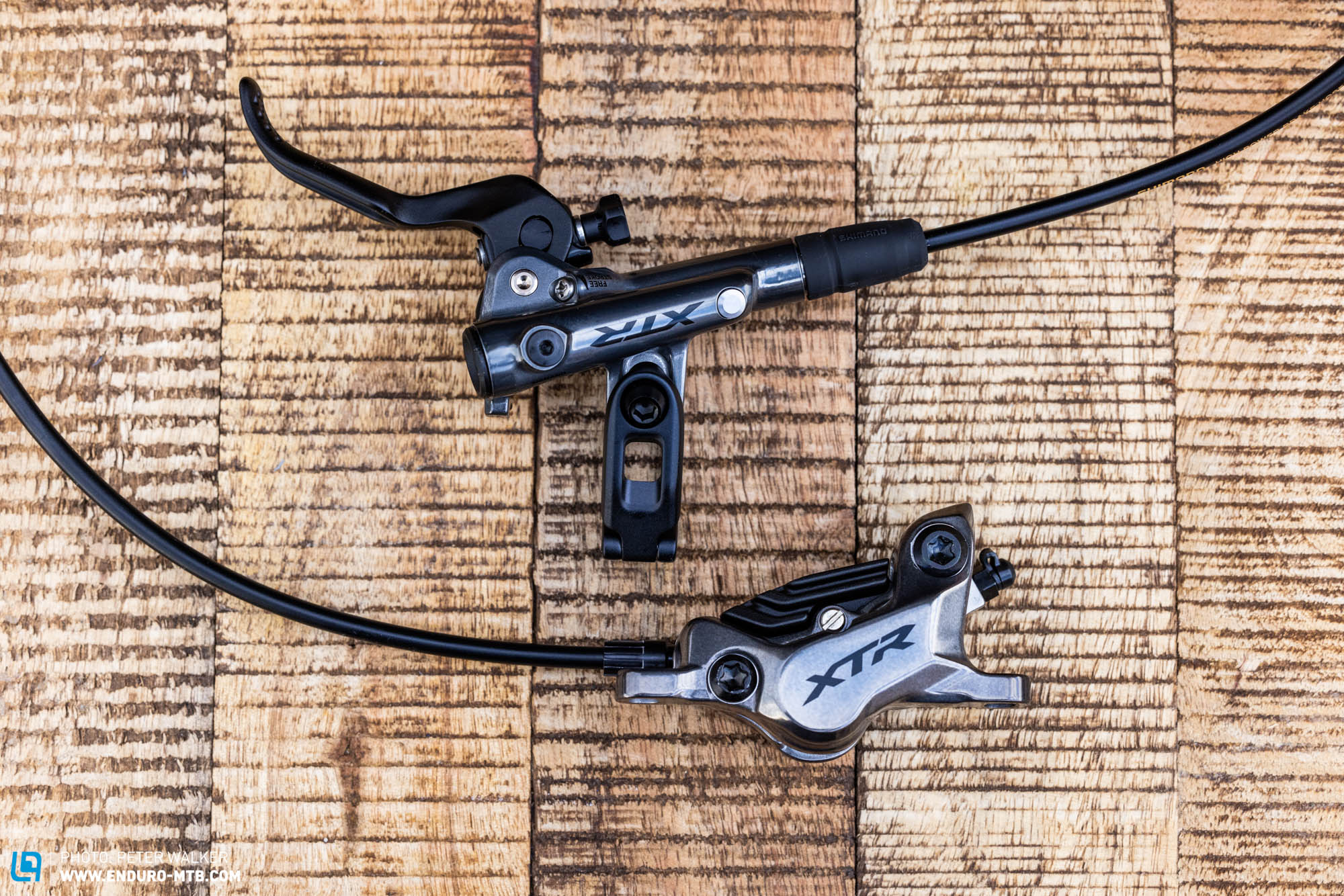The Shimano XTR M9120 is the lightest and priciest Shimano brake in this group test. What sets it apart from the competition, besides the great look and low system weight? Is the € 630 price tag justified for a lightweight, off-the-shelf brake, or does the XTR fall behind the test field?
Learn more about this comparison test: The best MTB disc brakes – 14 MTB brakes in comparison

Shimano are famous for their quality Japanese workmanship and their massive portfolio of bike components, which includes drivetrains, ebike motors and (of course) brakes. Their brake portfolio has remained unchanged for several years. Retailing at € 630, the XTR flagship model is the most expensive model in the range, putting it in the same price category as the SRAM Code Ultimate.
The four-piston Shimano XTR brake is usually found on lighter, top-tier bikes. The 552 g brake system is complemented by lightweight 149 g finned rotors. At first glance, the XTR looks a lot like its more affordable counterparts, with only the finish distinguishing it from the Shimano XT. The machined, one-piece handlebar clamp is designed to reduce weight too. However, it works exactly like the other Shimano clamps: just loosen the screw, push in the safety pin with a pointy object and fold open the clamp to remove it – easy!


Like all Shimano brakes, the XTR use mineral oil, which is relatively harmless on your skin and paintwork, so you’re safe as long as the oil doesn’t contaminate your brake pads. Moreover, Shimano brakes are amongst the easiest to bleed in the entire test field. The “One-way bleed” allows you to remove air bubbles from the system quickly and easily. Just thread the funnel with mineral oil onto the lever bleed port and pull the lever a few times – job done!

The Shimano XTR brakes on test
The Shimano XTR bite hard on the trail and share a near-identical brake feel as the Shimano XT, combining smooth actuation and a snappy pressure point, which is a lot more direct compared to brakes from SRAM, Hope and Trickstuff. The brake delivers its power right at the beginning of the lever stroke, but is nevertheless easy to modulate. In our lab tests, the Shimano XTR proved a smidge more powerful than the XT, lining up just behind SRAM’s new powerhouse, the MAVEN. Moreover, the braking temperature is 35° C lower than with the XT, which is due to the two piece rotors with aluminium core – although the braking torque is the same. This helps prevent brake fade on long, steep descents. Weight efficiency is the Shimano XTR’s unique selling point, combined with powerful deceleration. However, in view of the higher price and marginal performance gains, we’d opt for the cheaper Shimano XT – and if you want even more power, you can easily upgrade the pads with aftermarket products.
Our conclusions about the Shimano XTR
The Shimano XTR is an excellent brake that impresses above all with powerful deceleration, ease of maintenance and a low system weight. In the context of this comparison test, the € 630 price is pretty fair too. If you’re after a lightweight brake and elegant look, the Shimano XTR might be exactly what you’re looking for.
Tops
- Excellent one-piece clamp
- Very easy to bleed
- Very light brake rotors
- Plenty of braking torque
Flops
- Snappy on/off brake feel might not be everyone’s cup of tea
- Little added value over the Shimano XT
For more info, visit shimano.com
Find the overview of this comparison test here: The best MTB disc brakes – 14 MTB brakes in comparison
All brakes in test:
Formula Cura 4 | Hayes Dominion T4 | Hope Tech 4 V4 | MAGURA MT5 Pro | MAGURA MT7 | Shimano SLX | Shimano XT | Shimano XTR | SRAM CODE Bronze Stealth | SRAM CODE Ultimate Stealth | SRAM MAVEN Ultimate | Trickstuff MAXIMA | TRP DH-R EVO | TRP Trail EVO |
Did you enjoy this article? If so, we would be stoked if you decide to support us with a monthly contribution. By becoming a supporter of ENDURO, you will help secure a sustainable future for high-quality mountain bike journalism. Click here to learn more.
Words: Julian Schwede Photos: Peter Walker









